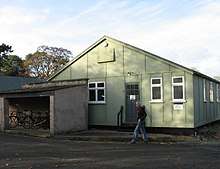Hut 8
Hut 8 was a section in the Government Code and Cypher School (GC&CS) at Bletchley Park (the British World War II codebreaking station) tasked with solving German naval (Kriegsmarine) Enigma messages. The section was led initially by Alan Turing. He was succeeded in November 1942 by his deputy, Hugh Alexander. Patrick Mahon succeeded Alexander in September 1944.[1]

| The Enigma cipher machine |
|---|
Hut 8 was partnered with Hut 4, which handled the translation and intelligence analysis of the raw decrypts provided by Hut 8.
Located initially in one of the original single-story wooden huts, the name "Hut 8" was retained when Huts 3, 6 & 8 moved to a new brick building, Block D, in February 1943.[2]
After 2005, the first Hut 8 was restored to its wartime condition, and it now houses the "HMS Petard Exhibition".[3]
Operation
In 1940, a few breaks were made into the naval "Dolphin" code, but Luftwaffe messages were the first to be read in quantity.[4] The German navy had much tighter procedures, and the capture of code books was needed (see Battle of the Atlantic § Enigma cipher) before they could be broken. In February 1942, the German navy introduced "Triton", a version of Enigma with a fourth rotor for messages to and from Atlantic U-boats; these became unreadable for a period of ten months during a crucial period (see Enigma in 1942).
Britain produced modified bombes, but it was the success of the US Navy bombe that was the main source of reading messages from this version of Enigma for the rest of the war. Messages were sent to and from across the Atlantic by enciphered teleprinter links.
Personnel
In addition to the cryptanalysts, around 130 women worked in Hut 8 and provided essential clerical support including punching holes into the Banbury sheets. Hut 8 relied on Wrens to run the bombes housed elsewhere at Bletchley.[1]
Code breakers
- Alan Turing
- Conel Hugh O'Donel Alexander
- Michael Arbuthnot Ashcroft[1]
- Joan Clarke [1]
- Harry Golombek
- I. J. Good
- Peter Hilton, January 1942 to late 1942
- Rosalind Hudson
- Charlie Bierman
- F Anthony Kendrick[1]
- Leslie Lambert (aka "A. J. Alan")
- Patrick Mahon[1]
- Rolf Noskwith[1]
- Richard Pendered[1]
- John H. Plumb, moved from Hut 3; (later a historian) [5]
- Shaun Wylie[1]
- Leslie Yoxall devised Yoxallismus technique
- Judith Irene Bloomfield
See also
References
- Noskwith 2011
- Secret Days: Code-breaking in Bletchley Park by Asa Briggs (2011, Frontline Books, London) p 70 ISBN 978-1-84832-615-6
- "Hut 8 Open Again", Radio and Communications Monitoring Monthly, 3 (4): 12, April 2008, ISSN 1749-7809.
- Secret Days: Code-breaking in Bletchley Park by Asa Briggs (2011, Frontline Books, London) p 75 ISBN 978-1-84832-615-6
- Briggs (2011) p.52
- Alexander, C. Hugh O'D. (c. 1945), Cryptographic History of Work on the German Naval Enigma, The National Archives, Kew, Reference HW 25/1
- Mahon, A.P. (1945), The History of Hut Eight 1939 - 1945, UK National Archives Reference HW 25/2, retrieved 10 December 2009
- Rolf Noskwith, Hut 8 from the Inside - pages 197-210 of Action this Day, edited by Michael Smith & Ralph Erskine (2001, Bantam London) ISBN 0-593-04910-1
- Noskwith, Rolf (2011). "Chapter 12: Hut 8 From the Inside". In Erskine, Ralph; Smith, Michael (eds.). The Bletchley Park Codebreakers. Biteback Publishing. pp. 184–194. ISBN 978-1849540780. (Updated and extended version of Action This Day: From Breaking of the Enigma Code to the Birth of the Modern Computer Bantam Press 2001)